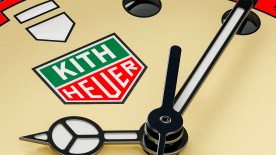Within a week of Frédérique Constant’s presentation of the first “horological smart watch”, other watch brands have followed suit with their own interpretations of what an intelligent watch should be. Swatch has presented a connected version of its touchscreen watch dedicated to the sport of beach volleyball with which the brand has had close ties for a number of years.

The most unlikely announcement, however, came from H. Moser & Cie, who have announced that they will soon be unveiling a smart watch “protected by multiple patents and powered by pioneering technology”. It will presumably be a “very rare” smart watch, too, although the mention of “an extremely long battery life” may be a step too far for the brand’s fans. Or is this just another audacious publicity stunt by the brand?

Despite their wildly different price points and philosophies, what connects the approaches of Frédérique Constant and H. Moser & Cie is that they are more about the “watch” than the “smart”, using the epitome of a classic watch face for the design. And this is where the Swiss watch industry has the upper hand. Its expertise in both the design and manufacture of watch movements, cases and dials make it best placed to put the emphasis on the “watch” in the smart watch. Let us not forget that while the smartphone may have revolutionised our world in less than ten years, the watch helped to organize the industrial revolution and it is still going strong over two hundred years later.
Beating the Big Apple
The most common concerns about smart watches (and the two features conspicuous by their absence from Apple’s presentation of its watch) are battery life and water resistance. Here, too, the experience of a Swiss watchmaker comes to play: Frédérique Constant offers a battery life of two years and water resistance guaranteed to 10 ATM (100 metres / 330 feet). The horological smartwatch also has another major advantage over the Apple Watch: it is compatible with the 80% of smartphones that run the Android operating system.
The Apple Watch almost seems a non-starter by comparison, but that is to ignore the huge sales and marketing clout of the world’s most valuable company. Apple’s market capitalization of over 750 billion dollars amounts to 30 times the value of the Swiss watch industry’s annual exports. And with a cash pile of some 180 billion dollars at its disposal, Apple can afford to plough resources into marketing, advertising and sales that no other rival can match. Devices running Apple’s iOS operating system now account for little more than 15% of all smartphone sales, but this didn’t stop Apple recording its most successful quarter ever in the last three months of 2014.
The Swiss smart watches will undoubtedly take a share of this burgeoning market, firstly from those with a closer affinity to traditional Swiss watchmaking (Peter Stas of Frédérique Constant is targeting a 30-45 year-old age group that is certainly different to Apple’s target group), perhaps later extending its appeal as smart watches become ever more popular. But how much will depend on how well the watch brands and their retailers can compete with the innovative advertising and sales methods of the established players.
As smart watch Pioneer Pebble, the darling of crowdfunding, has shown, it is easy to launch a smart watch. The hard part is selling them.








